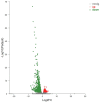The Role of Intestinal Microbial Metabolites in the Immunity of Equine Animals Infected With Horse Botflies
- PMID: 35812868
- PMCID: PMC9257286
- DOI: 10.3389/fvets.2022.832062
The Role of Intestinal Microbial Metabolites in the Immunity of Equine Animals Infected With Horse Botflies
Abstract
The microbiota and its metabolites play an important role in regulating the host metabolism and immunity. However, the underlying mechanism is still not well studied. Thus, we conducted the LC-MS/MS analysis and RNA-seq analysis on Equus przewalskii with and without horse botfly infestation to determine the metabolites produced by intestinal microbiota in feces and differentially expressed genes (DEGs) related to the immune response in blood and attempted to link them together. The results showed that parasite infection could change the composition of microbial metabolites. These identified metabolites could be divided into six categories, including compounds with biological roles, bioactive peptides, endocrine-disrupting compounds, pesticides, phytochemical compounds, and lipids. The three pathways involving most metabolites were lipid metabolism, amino acid metabolism, and biosynthesis of other secondary metabolites. The significant differences between the host with and without parasites were shown in 31 metabolites with known functions, which were related to physiological activities of the host. For the gene analysis, we found that parasite infection could alarm the host immune response. The gene of "cathepsin W" involved in innate and adaptive immune responses was upregulated. The two genes of the following functions were downregulated: "protein S100-A8" and "protein S100-A9-like isoform X2" involved in chemokine and cytokine production, the toll-like receptor signaling pathway, and immune and inflammatory responses. GO and KEGG analyses showed that immune-related functions of defense response and Th17 cell differentiation had significant differences between the host with and without parasites, respectively. Last, the relationship between metabolites and genes was determined in this study. The purine metabolism and pyrimidine metabolism contained the most altered metabolites and DEGs, which mainly influenced the conversion of ATP, ADP, AMP, GTP, GMP, GDP, UTP, UDP, UMP, dTTP, dTDP, dTMP, and RNA. Thus, it could be concluded that parasitic infection can change the intestinal microbial metabolic activity and enhance immune response of the host through the pathway of purine and pyrimidine metabolism. This results will be a valuable contribution to understanding the bidirectional association of the parasite, intestinal microbiota, and host.
Keywords: Equus przewalskii; RNA sequencing; differentially expressed genes; horse botfly; immune response.
Copyright © 2022 Hu, Tang, Wang, Qi, Ente, Li, Zhang, Li and Chu.
Conflict of interest statement
The authors declare that the research was conducted in the absence of any commercial or financial relationships that could be construed as a potential conflict of interest.
Figures








Similar articles
-
Transcriptome Analysis for Genes Associated with Small Ruminant Lentiviruses Infection in Goats of Carpathian Breed.Viruses. 2021 Oct 13;13(10):2054. doi: 10.3390/v13102054. Viruses. 2021. PMID: 34696484 Free PMC article.
-
Transcriptome analysis reveals differential immune related genes expression in bovine viral diarrhea virus-2 infected goat peripheral blood mononuclear cells (PBMCs).BMC Genomics. 2019 Jun 21;20(1):516. doi: 10.1186/s12864-019-5830-y. BMC Genomics. 2019. PMID: 31226933 Free PMC article.
-
Transcriptome profiling analysis of caeca in chicks challenged with Salmonella Typhimurium reveals differential expression of genes involved in host mucosal immune response.Appl Microbiol Biotechnol. 2020 Nov;104(21):9327-9342. doi: 10.1007/s00253-020-10887-3. Epub 2020 Sep 22. Appl Microbiol Biotechnol. 2020. PMID: 32960293
-
Metabolites of microbiota response to tryptophan and intestinal mucosal immunity: A therapeutic target to control intestinal inflammation.Med Res Rev. 2021 Mar;41(2):1061-1088. doi: 10.1002/med.21752. Epub 2020 Nov 10. Med Res Rev. 2021. PMID: 33174230 Review.
-
Protozoa: Pathogenesis and Defenses.In: Baron S, editor. Medical Microbiology. 4th edition. Galveston (TX): University of Texas Medical Branch at Galveston; 1996. Chapter 78. In: Baron S, editor. Medical Microbiology. 4th edition. Galveston (TX): University of Texas Medical Branch at Galveston; 1996. Chapter 78. PMID: 21413293 Free Books & Documents. Review.
References
-
- Zumpt F. Myiasis in Man and Animals in the Old World: Textbook For Physicians, Veterinarians and Zoologist. London: Butterworth; (1965).
-
- Soulsby E. Helminths, Arthropods and Protozoa of Domesticated Animals, 7th ed. London: Bailliere Tindall; (1982).
-
- Li K, Wu Z, Hu DF, Cao J, Wang C. A report on nw causative agent (Gasterophilus spp.) of the myiasis of Przewalski's horse occurred in China. Chin J Anim Vet Sci. (2007) 38:837–40. 10.3321/j.issn:0366-6964.2007.08.015 - DOI
-
- Xing J, Li P, Yan W Y. The dynamic observation on the immunological function of rat infected with Trichinella spiralis. Chin J Parasit Dis Control. (2005) 18:26–7. 10.3969/j.issn.1673-5234.2005.01.008 - DOI
LinkOut - more resources
Full Text Sources

